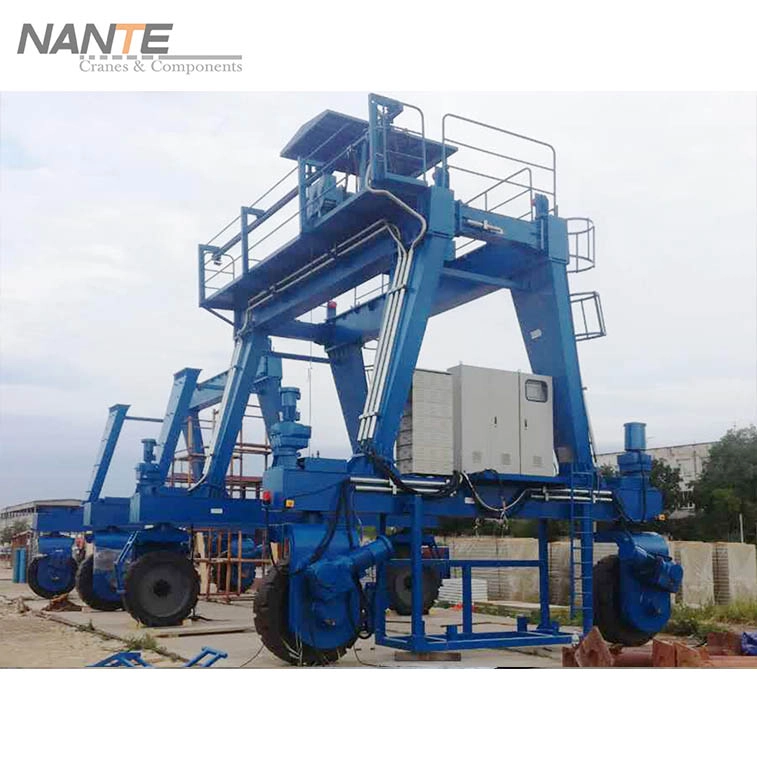How Does a Rubber Tyre Gantry Crane Work in Container Yards
Date: 2025-08-21 Share:
Introduction to Rubber Tyre Gantry Cranes
Global logistics move fast. Container handling must be quick to keep supply chains smooth. Rubber Tyre Gantry Cranes (RTGs) make this happen in container yards. They’re mobile cranes with wheels. They stack and move containers with great accuracy and ease. These cranes save space, cut downtime, and boost container terminal efficiency. This guide explains how RTGs work. It covers their mechanics, benefits, and uses. It also shows why they’re key for modern logistics. RTGs have smart designs. They shine in real-world tasks. Learn why they’re vital for container handling.
Key Components of a Rubber Tyre Gantry Crane
Rubber Tyre Gantry Cranes are built for strength and flexibility. Their main parts include:
- Gantry Frame: A strong steel structure. It holds the boom and hoist. It lifts heavy loads (40-50 tons) and stays steady.
- Boom and Spreader Mechanism: The boom stretches flat. It has a spreader with twist locks. These grab and move containers of different sizes.
- Rubber Tires: Eight or more big tires. They let the crane move freely on asphalt or concrete. No rails needed.
- Power and Control Systems: RTGs use electric or hybrid power. Hydraulic systems lift loads. Electrical controls ensure smooth moves.
- Safety Elements: Anti-sway tech, collision sensors, and comfy operator cabins keep handling safe and exact.
- Customization Options: RTGs stack up to 6+1 containers high. They can be adjusted for specific yard needs. This adds to rubber tired crane benefits.
These parts work together for flexible, efficient container stacking.
How a Rubber Tyre Gantry Crane Works: Step-by-Step Mechanics
RTGs combine mechanical, hydraulic, and electrical systems. Here’s how they work:
- Lifting Process: The spreader hangs from the boom. It uses twist locks to grab a container. Hydraulic systems lift it up. The crane can rotate for exact placement.
- Mobility and Navigation: Rubber tires run on electric or hybrid power. They let the RTG move across lanes, turn 90 degrees, and position over stacks. This makes quick moves easy in busy yards.
- Stacking and Grounding: The crane sets containers in neat rows. Anti-collision sensors guide it to avoid mistakes. It stacks up to 6+1 containers high. This uses yard space well.
- Energy Efficiency: New RTGs save energy. They capture power when lowering loads. This cuts energy use and emissions.
- Operator Role: Operators use a cabin or remote controls. Smart interfaces help. Automation handles repeat tasks, boosting RTG operation efficiency.
These systems make RTGs great for container handling in tough settings.
Rubber Tyre Gantry Crane Operations in Container Yards
RTGs are key for efficient container handling in yards. They stack and move containers from ships, trucks, or trains to storage spots. Here’s how they work:
- Workflow in Yards: RTGs unload containers from vehicles. They sort by size, type, or destination. Then, they stack them in rows. For outbound loads, they grab and load containers onto trucks or trains. This cuts handling time.
- Efficiency in Busy Terminals: RTGs move freely, unlike rail-mounted cranes. They switch lanes fast, saving time. They navigate tight spaces, boosting container terminal efficiency in busy ports.
- Integration with Yard Systems: RTGs link with yard software. This tracks containers in real time and plans stacks. GPS and automation improve moves in crowded yards.
- Case Scenarios: In a big port, an RTG stacks 40-foot containers for export. At the same time, it unloads imports. This saves space and speeds work. In small terminals, RTGs handle transfers, saving time and effort.
- Challenges and Solutions: Crowded yards can slow moves. But GPS and anti-collision systems ensure smooth, accurate work.
RTGs’ flexibility makes them vital for container stacking in all kinds of yards.
Benefits and Advantages of Using Rubber Tyre Gantry Cranes in Container Yards
RTGs bring big benefits to container yards:
- Enhanced Mobility: Rubber tires let RTGs move anywhere. No fixed rails needed. This allows flexible yard setups.
- Operational Efficiency: RTGs stack containers up to 6+1 high. They move fast, cutting handling time and labor costs.
- Cost-Effectiveness: RTGs need less setup than rail cranes. They’re cheaper to maintain and grow with operations.
- Safety and Reliability: Anti-sway tech, sensors, and strong designs keep work steady. They handle bad weather and cut accident risks.
- Environmental Impact: Electric or hybrid RTGs lower emissions. Energy recycling systems make them greener.
These rubber tired crane benefits make RTGs a key part of container terminal efficiency.
Maintenance and Best Practices for Rubber Tyre Gantry Cranes
To keep RTGs working well, follow these steps:
- Routine Checks: Look at tire wear, hydraulic fluid, and electrical systems. Check spreaders and twist locks for safe lifting. This prevents downtime.
- Safety Protocols: Train operators well. Follow ISO standards for reliable RTG operation.
- Longevity Tips: Plan maintenance to fix wear early. Lubricate parts and replace worn ones to extend crane life, especially in busy yards.
- Upgrades: Add smart tech, like sensors for predictive maintenance. This spots issues early and improves RTG operation.
These steps ensure RTGs run smoothly for steady container handling.
About Nante Crane: Company and Product
Frequently Asked Questions
What is the lifting capacity of a typical Rubber Tyre Gantry Crane?
A typical RTG lifts 40-50 tons. It handles standard 20- to 40-foot containers well.
How does an RTG differ from a rail-mounted gantry crane?
RTGs use rubber tires for easy movement. They don’t need rails, unlike rail-mounted cranes, which are less flexible.
Are Rubber Tyre Gantry Cranes suitable for all container yards?
Yes. RTGs work in small or growing terminals. They’re versatile for many container stacking needs.
What maintenance is required for RTGs?
Check tires, hydraulics, and software often. Lubricate parts regularly for smooth RTG operation and long life.
How can I learn more about Nante Crane’s RTG products?
Visit https://www.nantecrane.com/rubber-tyre-gantry-crane/#zhuti for specs, custom options, and inquiries.





